Micro Inverter Solar y Solar String Inverter también son adecuados para proyectos fotovoltaicos distribuidos, Pero su topología de productos y su diseño de circuito son fundamentalmente diferentes. Como cerebros de los sistemas solares fotovoltaicos, Los inversores juegan un papel clave para maximizar el potencial de la energía solar.
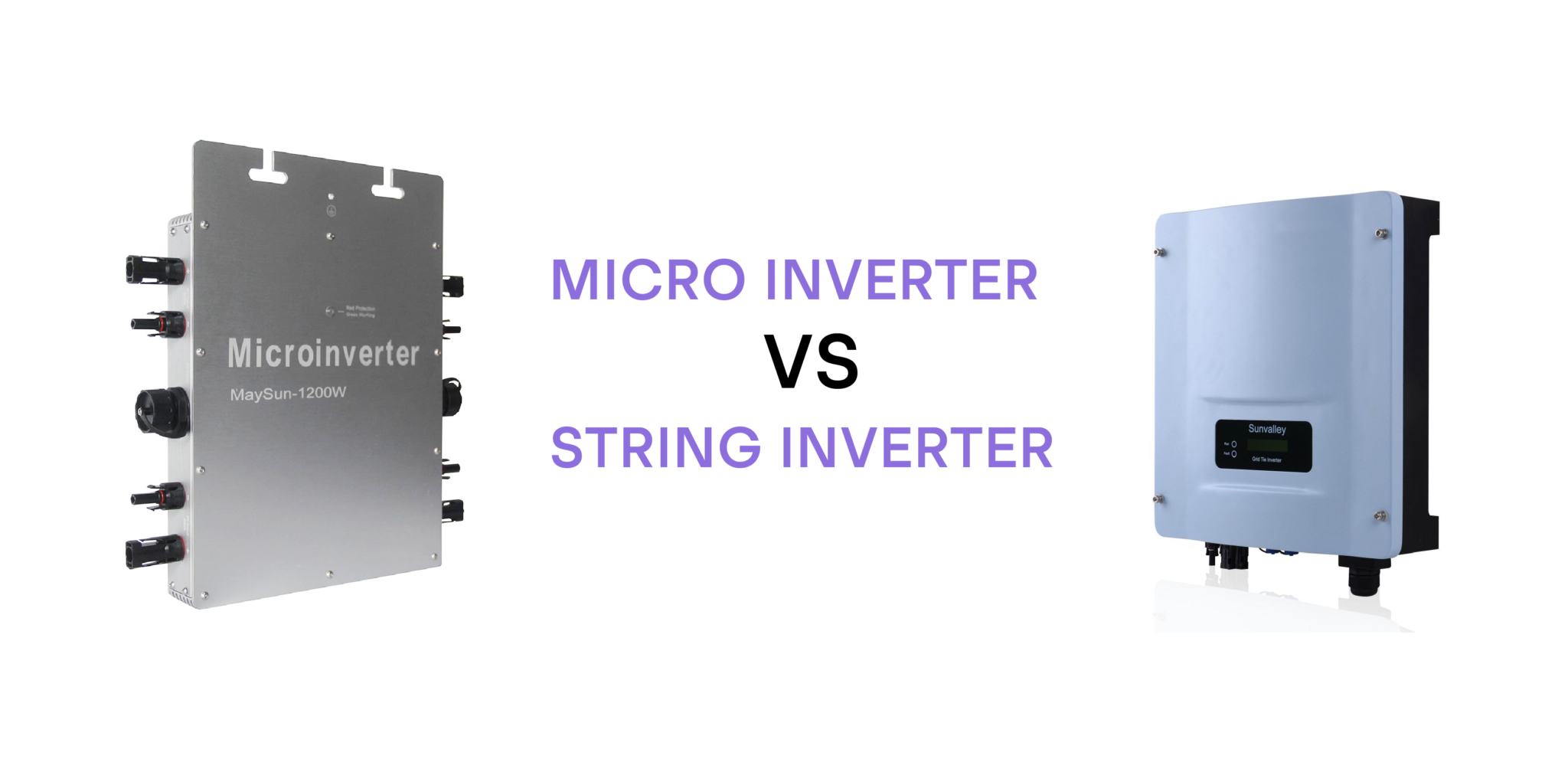
En este articulo, Exploraremos las diferencias entre el inversor solar de micro inversor e inversor solar , Explorando juntos qué tecnología de inversores podría ser la opción más adecuada para su hogar o negocio.
¿Qué es un microinversor solar??
El microinversor solar convierte la corriente continua generada por paneles solares individuales en un sistema solar fotovoltaico en corriente alterna necesaria para los electrodomésticos y la red eléctrica.. Se instala directamente detrás de cada panel solar.. Este diseño descentralizado no sólo mejora la eficiencia de todo el sistema, pero también permite ajustes individuales en caso de oclusión o desajustes del panel.
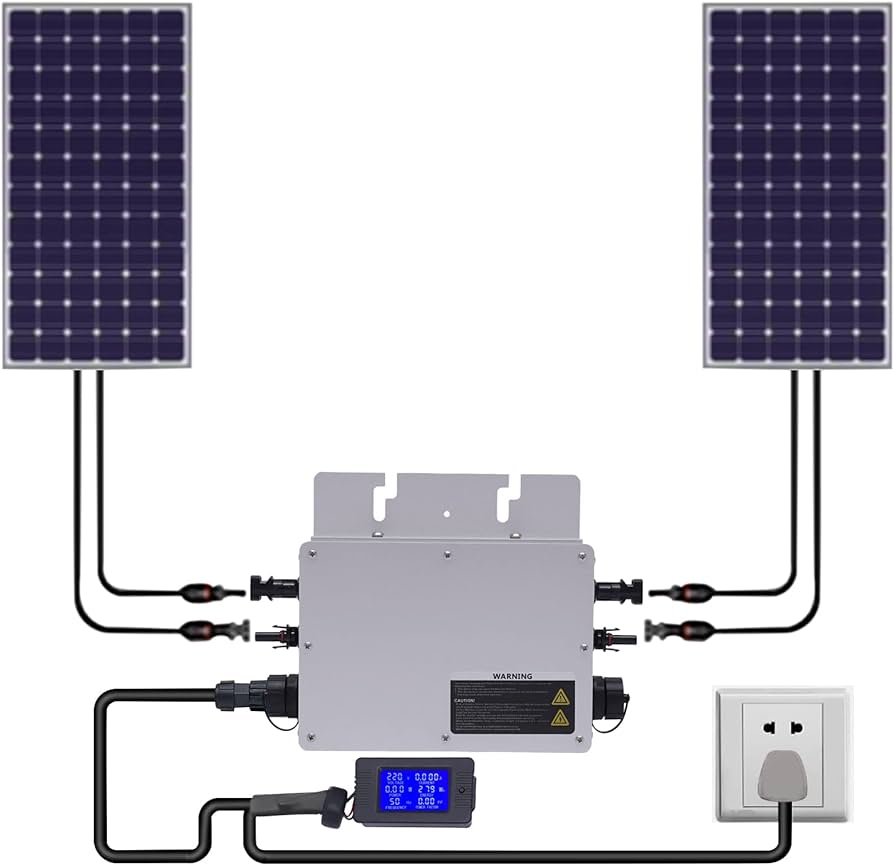
El microinversor solar consta de dispositivos semiconductores., como transistores bipolares de puerta aislada (IGBT) o transistores de efecto de campo semiconductores de óxido metálico (MOSFET), que ayudan a habilitar el proceso de conversión. Además, Contienen componentes como condensadores y transformadores., que se utilizan para regular el voltaje y garantizar la eficiencia de la conversión de energía..
¿Qué es un inversor de cadena solar??
Inversor de cadena solar, También conocidos como inversores centralizados., Son dispositivos utilizados en sistemas solares fotovoltaicos para convertir la corriente continua de múltiples paneles solares en serie en corriente alterna.. A diferencia de los microinversores, Los inversores de cadena están conectados a toda la cadena de paneles solares y generalmente se instalan en una ubicación central., como en una caja inversora o en una pared. Esta configuración simplifica la instalación y reduce la complejidad del cableado., ya que solo se requiere un inversor para todo el panel solar.
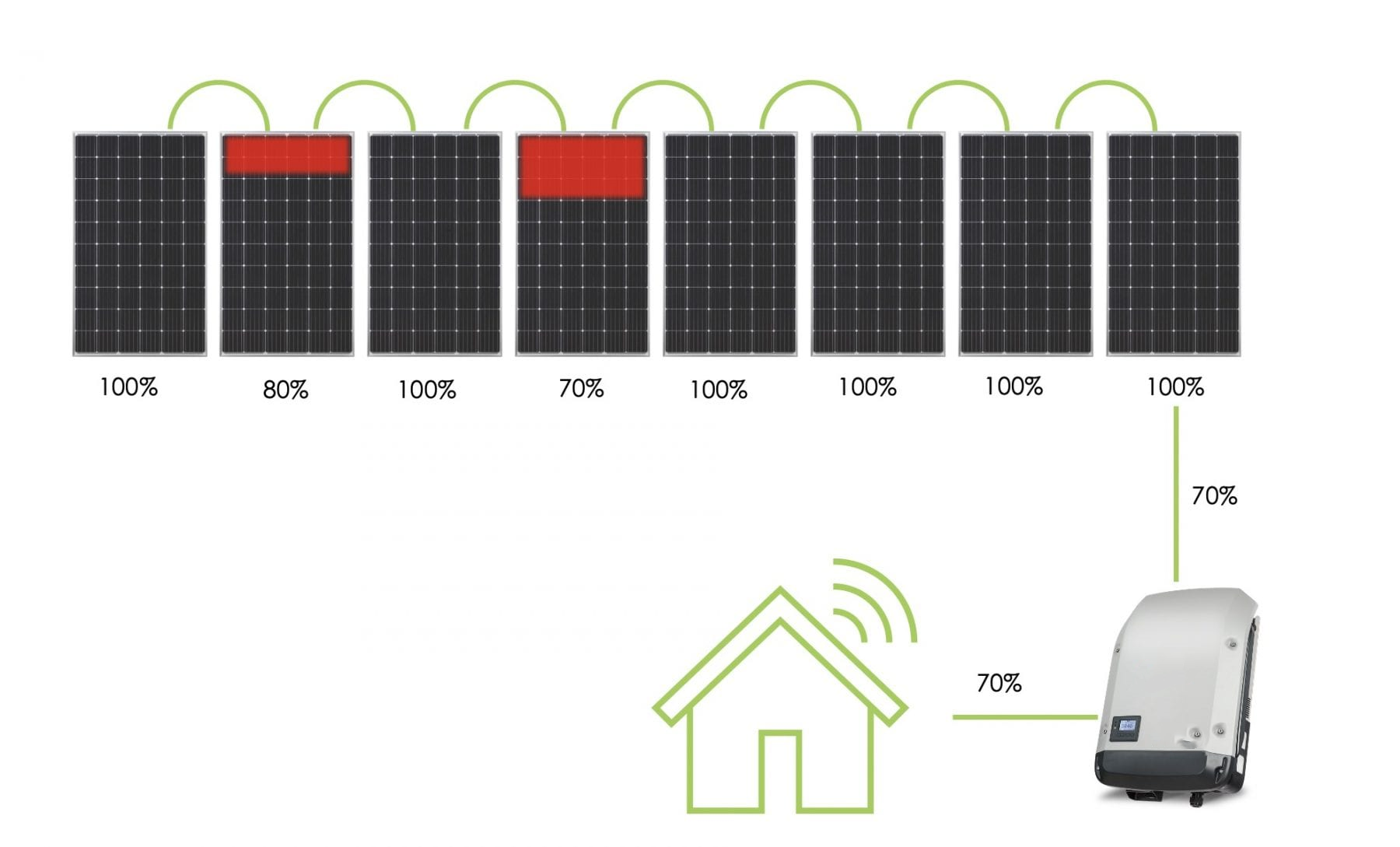
El inversor en serie convierte el voltaje de CC generado por todos los paneles de la serie en voltaje de CA a través de un solo paso de conversión. Además, Los inversores de tipo serie pueden tener capacidades de monitoreo limitadas en comparación con los microinversores, ya que normalmente solo proporcionan datos agregados para toda la matriz y no pueden mostrar información detallada sobre cada panel.
Ventajas y desventajas de Micro Inverter Solar
Ventajas
Escalado fácil: Permite una fácil escala del sistema y es adecuado para agregar más paneles solares a una configuración existente..
Monitoreo a nivel de panel: Los microinvertidores permiten el monitoreo individual de cada panel solar para que el usuario pueda ver claramente el rendimiento específico de cada panel.
Diseño flexible: Los micro inversores ofrecen una instalación flexible y son ideales para diseños de sistemas complejos con paneles en múltiples superficies de techo. Ya sea que se trate de un techo plano o un techo inclinado, se puede manejar fácilmente.
Operación independiente: En un sistema de microinversor, un problema en un panel no afectará el funcionamiento de otros paneles. Garantizar la estabilidad y eficiencia de todo el sistema..
Cumplimiento simplificado: Cumple con los requisitos de apagado rápido sin equipo adicional, simplificar el proceso de instalación y los pasos de cumplimiento.
Desventajas
Difícil de arreglar: Los problemas con los microinversores pueden ser difíciles de identificar y solucionar y requieren experiencia y conocimientos técnicos..
Precio más alto: En comparación con inversores centralizados e inversores en serie, El costo del micro inversor solar es mayor., lo que puede incrementar el presupuesto total del sistema.
Más puntos de fracaso: La gran cantidad de componentes en un sistema de microinversores significa más posibles fuentes de falla, lo que aumenta la necesidad de mantenimiento.
Gama limitada de aplicaciones: Suelen ser más adecuados para tejados de viviendas., relativamente pocos escenarios de aplicación, y no apto para todo tipo de sistemas solares.
Ventajas y desventajas del inversor de cadena solar
Ventajas
Solución de problemas sencilla: Dado que el sistema de inversor string tiene un solo inversor, Resolver problemas y solucionar problemas es muy simple y casi no requiere conocimientos técnicos..
Bajo costo: Generalmente son más baratos que los microinversores y son ideales para clientes con un presupuesto ajustado..
El diseño del sistema es simple: inversor serie tamaño pequeño, peso ligero, fácil de transportar e instalar. No hay necesidad de herramientas ni equipos especializados., ni para salas de distribución de energía especializadas, simplificando la construcción y reduciendo la huella en diversas aplicaciones.
Eficiencia de sombreado o problemas de un solo panel.: Aunque la sombra puede afectar el rendimiento general de un sistema de inversor de cadena, Algunos modelos tienen una mejor capacidad para hacer frente a esta situación..
MPPT Amplio rango de voltaje: Tiene un amplio rango de voltaje MPPT, generalmente 250-800V, hacer que la configuración de los componentes sea más flexible, y en días lluviosos y con niebla también puede tener un tiempo de generación de energía más largo.
Desventajas
Los problemas del inversor afectan a todo el sistema: Si un inversor string falla o tiene algún problema, todo el sistema solar puede verse afectado, provocando un apagado completo hasta que se solucione el problema.
No apto para grandes altitudes y ambientes al aire libre.: El espacio eléctrico del inversor de cadena solar es pequeño., no apto para zonas de gran altitud, instalación al aire libre, La carcasa y el radiador envejecen fácilmente debido al viento y al sol..
Impacto a nivel de panel: Un problema con un panel puede afectar la generación de energía de otros paneles en la misma cadena, afectando el rendimiento de todo el sistema.
Resumir
Si bien el microinversor solar y el inversor de cadena solar tienen ventajas y desventajas, La decisión final depende de factores como el diseño del sistema., condiciones de apagón, restricciones presupuestarias, y seguimiento de preferencias. Para encontrar la solución ideal para sus necesidades y objetivos únicos, un detallado Consulta con nuestros expertos de GycxSolar Solar. se recomienda.
¿Cuál es la diferencia entre el inversor solar micro inverter y el inversor solar de cuerda solar??
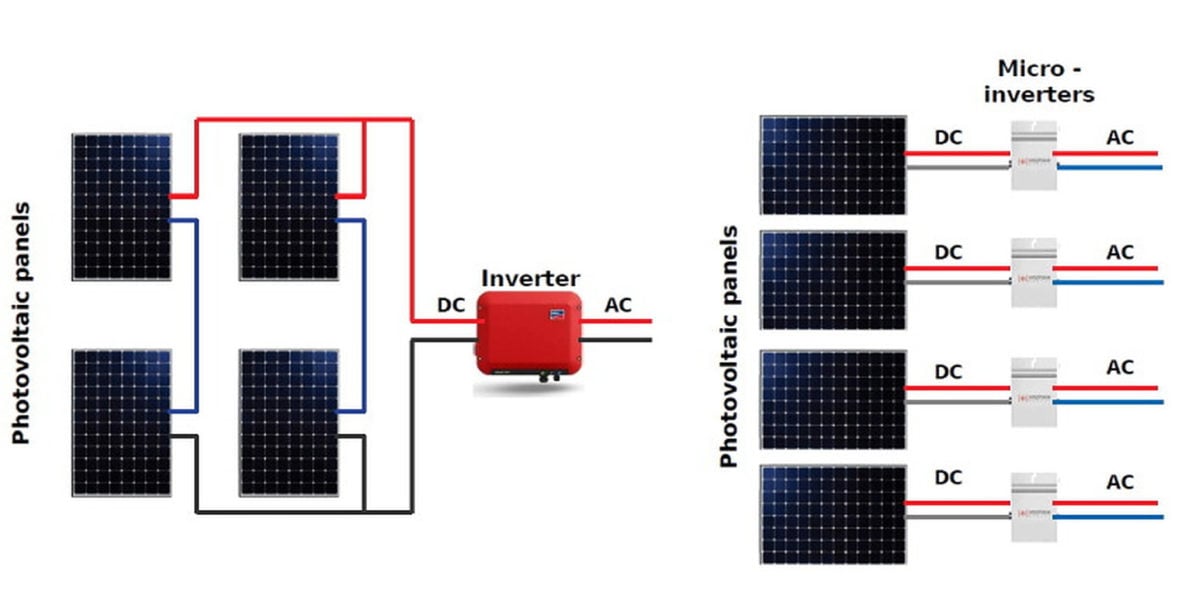
El microinversor solar y el inversor de cadena solar tienen diferencias significativas en diseño y aplicación., reflejado principalmente en el voltaje de trabajo, estructura, fuerza, escenarios de aplicación y métodos de instalación:
1.Voltaje de funcionamiento
Microinversor solar: Los módulos fotovoltaicos del sistema microinversor están en modo paralelo., No hay superposición de voltaje entre los componentes., Y el voltaje CC generalmente no supera los 120V.
Inversor de cadena solar: Cuando el sistema está funcionando, La acumulación de voltaje de línea de toda la serie generalmente puede alcanzar 600 V ~ 1000 V..
2.Construcción
Microinversor solar: Detrás de cada panel solar se monta un dispositivo compacto.
Inversor de cadena solar: Los inversores en serie se utilizan principalmente en sistemas de generación de energía fotovoltaica en tejados pequeños y medianos y en pequeñas centrales eléctricas terrestres., conectar múltiples paneles en serie.
3.Fuerza
Microinversor solar: producen menos energía por unidad que los inversores string.
Inversor de cadena solar: Capaz de gestionar todo el panel solar y ofrecer una mayor potencia de salida por unidad.
4.Escenarios de aplicación
Microinversor solar: Ideal para sistemas con patrones de techo complejos, problemas de sombreado, o cambios en la orientación del panel.
Inversor de cadena solar: Ideal para paneles con orientación constante y menos sombras en el sistema.
5.Forma de instalar
Microinversor solar: diseño modular, talla pequeña, peso ligero, Se puede instalar directamente sobre el soporte fotovoltaico., enchufar y jugar, Básicamente no ocupa el espacio de instalación de forma independiente.. Durante la expansión del sistema, Puede seleccionar la cantidad de inversores según los requisitos reales para lograr una expansión flexible..
Inversor de cadena solar: Cada “cadena” está conectada en serie, generalmente se instala cerca de una serie de componentes mediante el uso de soportes fijos o equipos de instalación de aros fijados en la columna, También se puede instalar en la pared adyacente..
¿Cuáles son los buenos? Inversores solares Marcas?
Los inversores solares son los héroes detrás de escena de los sistemas de paneles solares que convierten la energía solar en electricidad que los electrodomésticos pueden usar.. A continuación se muestran algunos inversores populares que son marcas confiables..
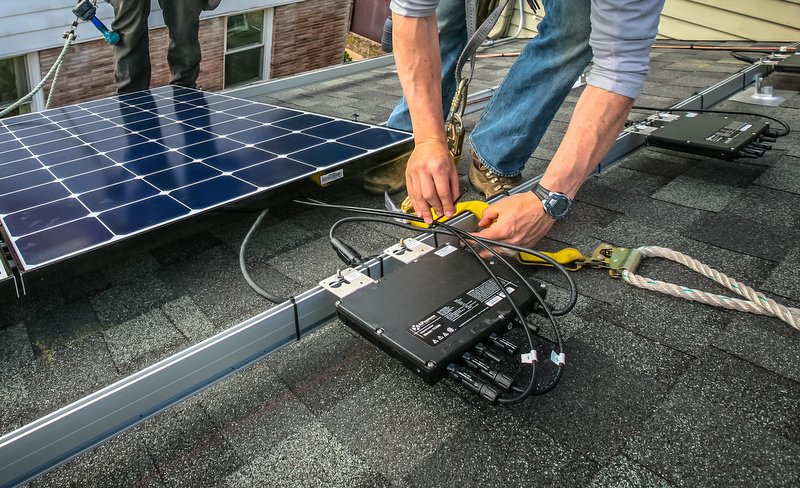
¿Son los microinversores más eficientes que los inversores de cadena??
En sistemas con apagones o rendimiento inconsistente del panel, Los microinversores tienden a ser más eficientes que los inversores de cadena.. Porque los microinversores pueden optimizar de forma independiente la salida de cada panel, Reducen el impacto de los problemas de sombreado o desajuste en todo el sistema.. Sin embargo, en condiciones ideales sin sombra y con plena luz solar, la diferencia de eficiencia entre los dos es en realidad pequeña y casi insignificante.
¿Son los microinversores solares más seguros que los inversores solares de cadena??
Tanto los microinversores como los inversores string están diseñados para cumplir estrictos requisitos de seguridad.. Sin embargo, Los microinversores proporcionan seguridad adicional.. Limita el voltaje al alcance de un solo panel solar., reducir el riesgo de arcos CC de alto voltaje. Además, El diseño descentralizado de los microinversores minimiza la posibilidad de un único punto de fallo., mejorando así la seguridad y confiabilidad de todo el sistema.
¿Es un microinversor más caro que un inversor de cadena??
Porque los microinversores pueden optimizar y monitorear individualmente cada panel, sus costos iniciales suelen ser más altos que los de los inversores de cadena. Sin embargo, El coste total de propiedad de todo el sistema puede variar a lo largo de su vida útil., dependiendo de factores como el rendimiento del sistema, necesidades de mantenimiento, y cobertura de garantía. Para tu sistema solar, Es importante sopesar el coste a corto plazo de un microinversor frente a las ventajas a largo plazo..
Microinversores vs.. Inversores de cadena: ¿Cuál es mejor para tu hogar??
La elección del inversor solar adecuado para usted depende en última instancia del entorno de su hogar y del tipo de instalación solar..
Si el diseño de su techo es relativamente simple, Los paneles solares solo se instalan en un lado de la casa., y no hay muchos problemas de sombra, Le recomendamos comprar un inversor string y un optimizador DC.. Los optimizadores le permiten maximizar la generación de energía de sus paneles solares mientras disfruta de la comodidad y el precio más bajo de un solo inversor..
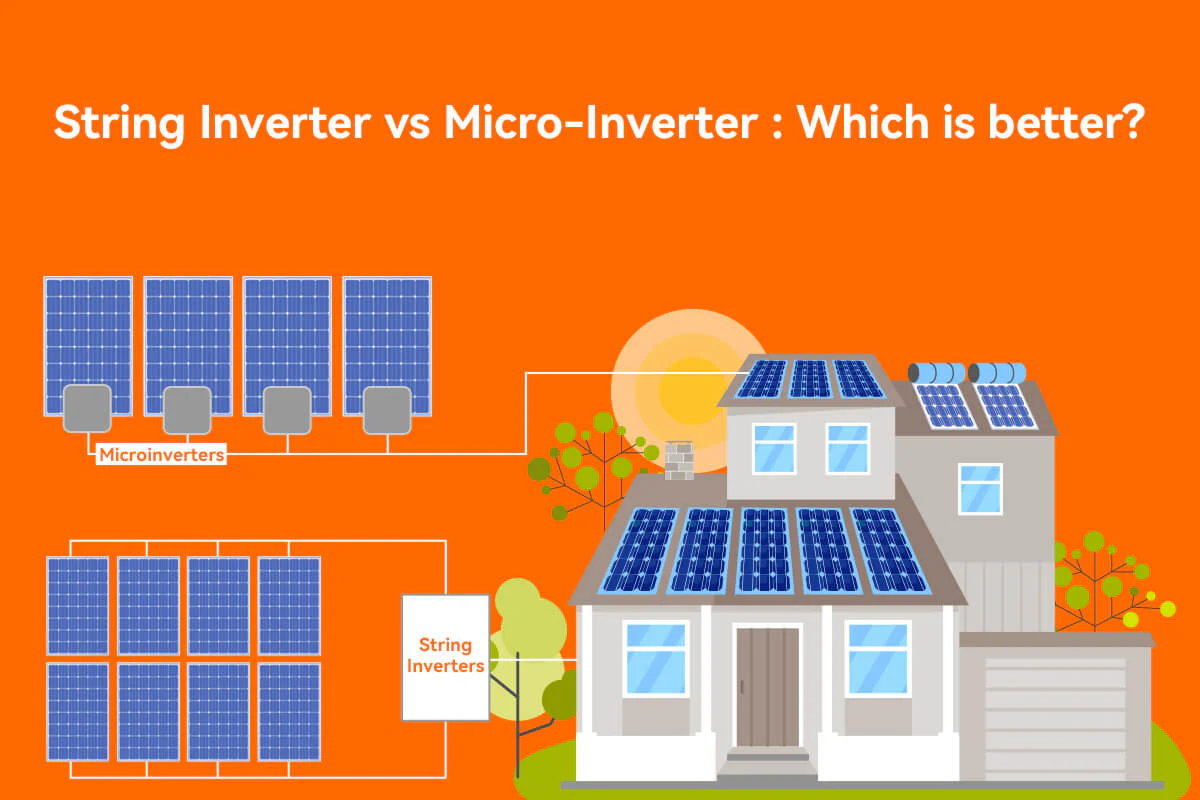
Si el diseño de su sistema es más complejo, como paneles solares instalados en múltiples planos de techo, entonces un micro inversor es una mejor opción. Además, si sus paneles solares están parcialmente sombreados durante el día, un micro inversor puede aumentar mejor la generación de energía de cada panel. Aunque el precio inicial puede ser mayor, Ahorrarás más maximizando la generación de energía por panel..
Conclusión
Los dos productos inversores tienen sus propios escenarios de aplicación de subdivisión adecuados y ventajas de aplicación., en la comparación y selección de microinversores e inversores en serie, es necesario elegir el tipo de inversor apropiado según las condiciones locales.
Con la mejora continua de los requisitos de las centrales fotovoltaicas en términos de seguridad., Eficiencia del sistema y operación y mantenimiento inteligentes., La aplicación de los microinversores será cada vez más amplia.. Si estás interesado en inversores y tienes necesidades, puedes referirte a Inversores solares Gycx, Espero que esta información te sea útil..
